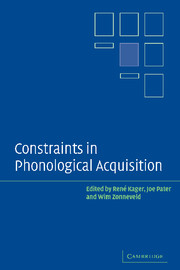Book contents
- Frontmatter
- Contents
- List of contributors
- Abbreviations
- Preface
- 1 Introduction: constraints in phonological acquisition
- 2 Saving the baby: making sure that old data survive new theories
- 3 Markedness and faithfulness constraints in child phonology
- 4 Input elaboration, head faithfulness, and evidence for representation in the acquisition of left-edge clusters in West Germanic
- 5 Phonological acquisition in Optimality Theory: the early stages
- 6 Syllable types in cross-linguistic and developmental grammars
- 7 Bridging the gap between receptive and productive development with minimally violable constraints
- 8 Learning phonotactic distributions
- 9 Emergence of Universal Grammar in foreign word adaptations
- 10 The initial and final states: theoretical implications and experimental explorations of Richness of the Base
- 11 Child word stress competence: an experimental approach
- Index of subjects
- Index of names
4 - Input elaboration, head faithfulness, and evidence for representation in the acquisition of left-edge clusters in West Germanic
Published online by Cambridge University Press: 22 September 2009
- Frontmatter
- Contents
- List of contributors
- Abbreviations
- Preface
- 1 Introduction: constraints in phonological acquisition
- 2 Saving the baby: making sure that old data survive new theories
- 3 Markedness and faithfulness constraints in child phonology
- 4 Input elaboration, head faithfulness, and evidence for representation in the acquisition of left-edge clusters in West Germanic
- 5 Phonological acquisition in Optimality Theory: the early stages
- 6 Syllable types in cross-linguistic and developmental grammars
- 7 Bridging the gap between receptive and productive development with minimally violable constraints
- 8 Learning phonotactic distributions
- 9 Emergence of Universal Grammar in foreign word adaptations
- 10 The initial and final states: theoretical implications and experimental explorations of Richness of the Base
- 11 Child word stress competence: an experimental approach
- Index of subjects
- Index of names
Summary
Preliminaries
Several recent investigations of the development of left-edge clusters in West Germanic languages have demonstrated that the relative sonority of adjacent consonants plays a key role in children's reduction patterns (e.g., Fikkert 1994, Gilbers and Den Ouden 1994, Chin 1996, Barlow 1997, Bernhardt and Stemberger 1998, Gierut 1999, Ohala 1999, Gnanadesikan this volume). These authors have argued that, for a number of children, at the stage in development when only one member of a left-edge cluster is produced, it is the least sonorous segment that survives, regardless of where this segment appears in the target string or the structural position that it occupies (head, dependent, or appendix). To illustrate briefly, while the more sonorous /S/ is lost in favour of the stop in /S/+stop clusters, /S/ is retained in /S/+sonorant clusters; similarly, the least sonorous stop survives in both /S/+stop and stop+sonorant clusters, in spite of the fact that it occurs in different positions in the two strings. To account for reduction patterns such as these, a structural difference between /S/-initial and stop-initial clusters need not be assumed. This would seem to fare well in view of much of the recent constraint-based literature which de-emphasises the role of prosodic constituency in favour of phonetically based explanations of phonological phenomena (see, e.g., Hamilton 1996, Wright 1996, Kochetov 1999, Steriade 1999, Côté 2000).
- Type
- Chapter
- Information
- Constraints in Phonological Acquisition , pp. 109 - 157Publisher: Cambridge University PressPrint publication year: 2004
- 56
- Cited by



